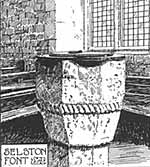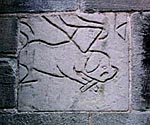
Norman archway inside South porch.
The south door of the church is of the same date as the south arcade. The arch moulding does not fit over all the capitals, and two rows of dog-tooth are carved on the east jamb between the columns, while the west jamb is plain.
The outer door to the porch has a plain, pointed, chamfered arch, springing from two carved impost stones. The carving is shallow: the east jamb is decorated with three heads wearing coifs, and the west with two heads with foliage of a square character springing from the mouths. The only relics of the work of the 14th century now remaining are, part of a window-head built into the east window of the south aisle, and a simple two-light geometric window on the south side of the chancel. The chancel wall, where this window is, has been considerably thickened for some reason not apparent.
The work of the 15th century is seen in the three-light east window and the whole of the tower. On the battlement, on the south side of the tower, are the letters J. and M.,— Jesus and Mary. Also, the letters T. S. with a shield, bearing a bend between a pierced mullet and an annulet. Mr. George Fellows is of opinion that these are the arms of the Samons. The Samons were at Annesley Woodhouse, and of the same family as John Samon, of Nottingham, who contributed to the building of St. Mary’s Church there.
These arms seem to indicate that a Samon helped in the building of Selston tower. The tower was supposed to have been built by an Annesley, as it was thought that the stone came from some Annesley quarry. This theory perhaps gives us the clue to the exact part played by the Samons, viz., that the stone was provided by a member of that family.
Other items belonging to the 15th century are the nave, south aisle roofs, and the clerestory windows.
The carved stone corbels in the nave supporting the roof principals are worth inspecting.
The work of the 15th century is of a rather late character; notice the height of the arch between the nave and tower. Earlier arches in this position are usually low, and it is not until the later Gothic building that the tower arch was made to extend to nearly the whole height of the nave.

At the west end of the south aisle stands the old bucket-shaped Norman font, decorated with a single band of cable moulding. It will be seen that it is badly worn, a condition explained by its varied history. Over a hundred and fifty years ago it was removed from the church and carried to Blackwell. After a time it was brought back to Selston, where it did duty as a trough under the pump at the village inn, the “Bull and Butcher.” Then it was used as a vase in a private garden. Eventually, through the energy of the vicar (Rev. C. Harrison), it was recovered and once more placed in the church. The worn appearance of the top is due to its having been used as a knife-sharpener.
Another relic recovered by the vicar is the Jacobean communion table, which, like the font, also shows signs of wear.
 |
Within the communion rails on the south side is an incised slab of a priest wearing an alb, chasuble and maniple, and holding a chalice.
Mr. W. Stevenson considers this slab to be the lid of a stone coffin dating from the last half of the 12th century, or the first half of the 13th century. He thinks it might he to one of the old rectors of Selston, or to a priest of the old chapel of Wandesley, where half a church is mentioned in Domesday. This church seems to have come down as a private chapel of the Wandesleys served by the priory of Felley, and any canon dying at Wandesley would be buried in Selston.
At the west end of the nave, under the tower, is another incised slab of an unusual character, having a wheel-like ornament at the top and a sword on the left side. Mr. W. Stevenson states that he takes this to be a memorial to a knight, dating earlier than 1289.
 |
In the outer wall of the north aisle a fragment of another incised slab is to be seen. On it are lines of drapery and a dog with a bone in its mouth. It is evidently the bottom part of a slab to a lady.
Lying outside under the east window are fragments of other slabs, some of which have been used as window-cills, and the alabaster portions seem to have been part of a memorial to an ecclesiastic.
In the chancel is a fine monument to William Willoughby and Anne, his wife. He died 12th November, 1630, aged twenty-one and three-quarter years. This tomb is said to have been originally in one of the chancel chapels, probably the south. It shows signs of weather and wear, which bears out this theory, as it would probably be moved when the chancelchapel fell into ruin, it will be noticed that new parts have been inserted, of stone instead of alabaster.
Near to this tomb on the north wall of the chance! is a slab bearing the following inscription:
“To the death of that well deserving gentleman who departed this life November 12th, 1630, interred beneath this monument doth lie as great perfection as with man could die, which more enoble him than birth or blood, since it’s less worthy to be great than good. His noble ways blazoned his progeny and proved him a right true born Willoughby. If ere thou knew’st him living drop a tear, not cause he’s dead, but cause we want him here. Whose goodness gain’d him love, true worth, renown, good life, good end, and that good end a crown—of glory, in the heavens which he inherits in right of faith and all his Saviour’s merits. Yet left he ere he went behind a pair of female babes, besides his infant heir, a hopeful imp, a right young Willougby, in whom love portrayed my world’s bright eye, his father’s gentle parts. Of our others, one of those fair virgin babes, since from us gone to bear her father company, the other surviving the joys to wait upon her sweet mother whose virtues merit long to enjoy in this world all that’s good, in other world all bliss.”
Suspended on the south wall of the chancel is a helmet and the tattered fragments of a banner. These are part of the funeral achievements of a Willoughby, probably the one just mentioned.
Of the Willoughby family, Torre says—“About temp. Elizabeth Mr. Timothy Pusey purchased the lordship, from whose daughter and co-heir it descended to her son Sir William Willoughby, Baronet, who dyed here on the 10th February, 1670, without lawful issue.” This would be the “hopeful imp” spoken of in the slab.
In the churchyard near the north side of the tower are the remains of the gravestone to Dan Boswell, the “king of the gipsies.” The inscription is now all but gone, but was:–
“I’ve lodged in many a town,
I’ve travelled many a year,
But death at length has brought me down,
To my last lodging here.”
Beneath the cill of the east window is a small recess in the external wall Mr. Harry Gill, in his paper on “the low side windows of Nottinghamshire,” printed in the Thoroton Society’s Transactions for 1910, says :—
“Its purpose may have been to contain a picture, painted on glass, and placed so as to he seen above the altar from within when illuminated by a lamp placed behind it. There is a similar recess, known to have been made for this purpose at Hickling.”
On the inside of the chancel are two brackets, north and south of the east window, probably where figures formerly stood.
Under the tower are the royal arms in a frame. They used to hang over the chancel arch.
The vicar has in his possession a wind instrument, a relic of the old choir band. It is said to have been used in Selston church for over 200 years.
The list of rectors and vicars commences in 1176. The fact that the first recorded rector was “Adam” will explain the allusion in the vicar’s welcome to his being the thirty-ninth from Adam.
The registers date from 1557. In them are entries of the Middleton, Willoughby, Dixie, Pusey, Savile and Babington families. Entries dealing with nonconformity in the 18th century are found as: –1703, November 12th, Edward, son of Jonathan and Mary Clee, born and baptised by a dissenting teacher in a barn on Dove Green.
The Cromwellian portion of the registers is interesting, and on one page is given a list of the faithful, headed:—
“The church of Christ, ye officers, members thereof that continue breaking of bread and walking in ye apostles doctrine, associated and retained into church fellowship within ye prescints of Selston which are are the persons hereafter written—Charles Jackson, pastor of ye church of Selston, &c., &c.”
The next place visited was Castle Hill adjoining Kirkby-in-Ashfield
church. The site was reached by way of the hilly road past Kirkby Old
Hall, the home of the Sacheverell and Coke families, and Langton Hall,
where the Salmonds have long resided. Some account of Castle Hill, where
the remains are now very scanty, will be found in the paper on Ancient
Earthworks, in Vol. I. of the Victoria History of Notts. On the occasion of the Society's visit, Mr. G. G. Bonser read the following
paper.
